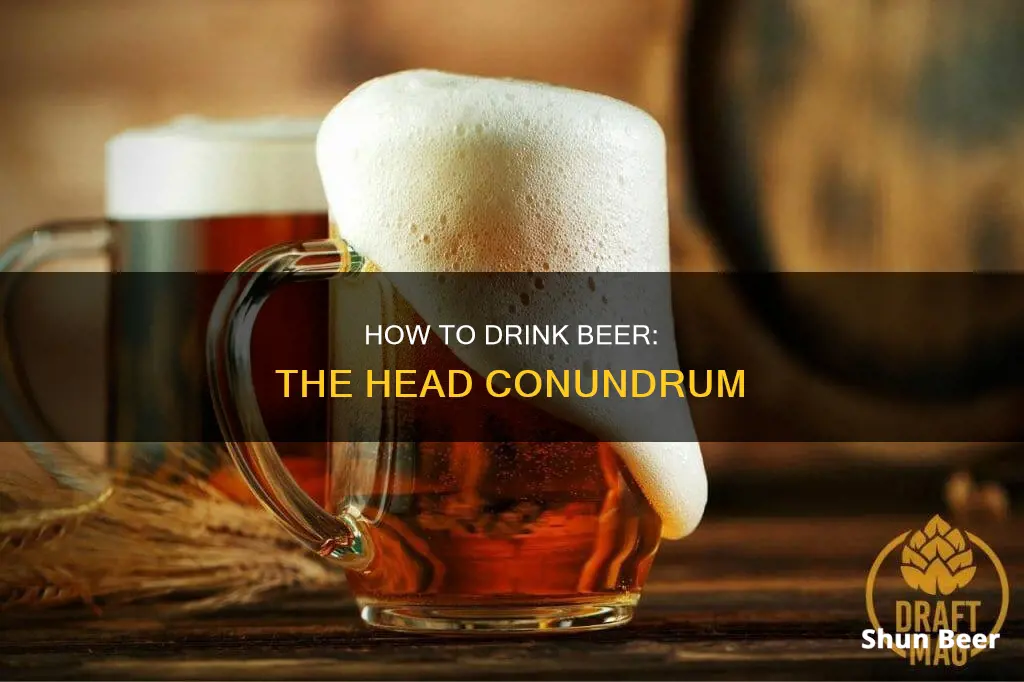
Beer head, also known as the collar, is the foamy substance that forms at the top of a beer. It is created by the carbon dioxide produced during the fermentation process as yeasts break down sugar-rich molecules to produce ethanol and carbon dioxide. The head of a beer is important for several reasons. Firstly, it acts as a quality control measure, indicating that the beer is fresh and has not gone stale. Secondly, it enhances the aroma and flavour of the beer, allowing drinkers to pick up on the distinct scent and flavour notes. Additionally, the head affects the mouthfeel of the beer, ranging from highly effervescent to soft and creamy. The perfect amount of head on a beer is generally considered to be around half an inch to an inch, although this may vary depending on personal preference and the type of beer.
| Characteristics | Values |
|---|---|
| What is it called? | Beer head, head, collar, beer foam |
| Is it desirable? | Yes, but too much is undesirable |
| Why is it desirable? | It improves the taste, aroma, and mouthfeel of the beer |
| How much is desirable? | 0.5-1 inch |
| How is it formed? | By carbon dioxide interacting with foam-positive proteins like the Lipid Transfer Protein (LTP1) |
| How to achieve a good head? | Pour the beer at a 45-degree angle into the middle of the glass, then tilt the glass to a 90-degree angle and continue pouring |
What You'll Learn
- Beer foam is created by the carbon dioxide produced during fermentation
- The density and longevity of the head depend on the type of malt and adjunct used in fermentation
- The head of a beer adds aroma and initial flavour to the first sip
- The head of a beer reduces bloating by releasing carbon dioxide
- The head of a beer is called a collar

Beer foam is created by the carbon dioxide produced during fermentation
Beer foam, or the "head", is the frothy foam on top of beer and carbonated beverages. It is produced by bubbles of gas, predominantly carbon dioxide, rising to the surface. The carbon dioxide is produced during fermentation as yeasts break down sugar-rich molecules to produce ethanol and carbon dioxide.
The process of fermentation involves yeast breaking down sugars in the wort, which is a mixture of malted barley, hops, and water. This fermentation process produces ethanol and carbon dioxide as by-products. The carbon dioxide forms bubbles that rise to the surface, creating the foam head on the beer.
The density and longevity of the head are determined by the type of malt and adjunct used in fermentation, as well as the mash schedule and cereal sources. For example, wheat tends to produce larger and longer-lasting heads compared to barley.
The head on a beer is not just about aesthetics; it also plays a crucial role in the overall quality of the beer. The foam helps to retain the carbonation and enhances the mouthfeel of the beer, making it smoother and thicker. Additionally, the head contributes to the aroma and flavour of the beer, as the carbonation releases the beer's distinct scent and flavour notes.
The formation of beer foam is a complex process influenced by various factors, including the presence of carbon dioxide, wort proteins, yeast, and hop residue. The carbonation can occur naturally during fermentation or artificially through forced carbonation using pressurized gas. The type of glassware and pouring technique can also impact the formation and retention of the beer head.
Beer and Low-Fat Diets: Friends or Foes?
You may want to see also

The density and longevity of the head depend on the type of malt and adjunct used in fermentation
The density and longevity of a beer's head are influenced by the type of malt and adjunct used in the fermentation process. The head is formed by bubbles of carbon dioxide rising to the surface of the beer. The carbon dioxide is produced during fermentation as yeast breaks down sugar-rich molecules to create ethanol and carbon dioxide. The type of malt and adjunct used in fermentation will influence the density and longevity of the head because they affect the levels of carbonation in the beer.
Adjuncts are unmalted grains or grain products that supplement the main mash ingredient, such as malted barley. They are often used to cut costs, but they can also be used to create additional features such as better foam retention, flavours, or nutritional value. In the context of head retention, adjuncts can be used to create a lasting head. For example, wheat is often added to pale ale to create a lasting head. Wheat tends to produce larger and longer-lasting heads than barley.
The type of malt used in fermentation will also impact the density and longevity of the head. For example, American and Continental malts are less modified, which means they retain more of the endosperm for fermentability. This results in greater nitrogen complexity but reduced enzyme activity. On the other hand, six-row barley has higher diastatic power, which means it has more enzymes. The choice of malt will impact the carbonation levels in the beer and, consequently, the density and longevity of the head.
Flat Beer: Drink or Ditch?
You may want to see also

The head of a beer adds aroma and initial flavour to the first sip
The head of a beer, also known as the "collar", is the frothy foam on top of a beer or carbonated beverage. It is produced by bubbles of gas, predominantly carbon dioxide, rising to the surface. The head of a beer is important for several reasons. Firstly, it serves as a quality control measure, indicating whether the beer is fresh. The presence of a head means that the beer still has carbon dioxide content and is therefore fresh. Secondly, the head adds to the aroma and initial flavour of the beer. The foam brings the odour compounds to the surface, allowing you to experience the full range of flavours. This is why serious beer drinkers sniff the foam head to pick up on the different flavour notes and the distinct scent of the beer.
The density and longevity of the head depend on the type of malt and adjunct used in the fermentation process. Different mash schedules and cereal sources also influence head retention. For example, wheat tends to produce larger and longer-lasting heads compared to barley.
The process of creating a head on a beer involves the nucleation of bubbles. The head consists of proteins that are acted upon by the hops, yeast, and carbonation. The bitter Iso-alpha acids (IAAs) derived from hops interact with the hydrophobic polypeptides of the brewing grain, resulting in a denser and more stable foam that clings to the glass. The foam-forming ingredient in beer, known as albumin, forms complex bonds with the bitter hop compound, making it easier for the bubbles to stick together and stabilise the foam.
The head of a beer is not just about taste and aroma but also has aesthetic value. A perfectly poured beer with a foamy head is visually striking and adds to the overall drinking experience. However, the amount of head on a beer is a matter of personal preference. While some people prefer a little more foam, others might opt for less or none at all. Ultimately, the head of a beer enhances the sensory experience by bringing out the aroma and initial flavour of the beverage.
Should Large Dogs Drink Beer?
You may want to see also

The head of a beer reduces bloating by releasing carbon dioxide
The foamy head on a beer is a result of the nucleation process, where bubbles form due to carbon dioxide interacting with hydrophobic proteins. This foam is desirable for several reasons. Firstly, it acts as a quality control measure, indicating that the beer is fresh and has adequate carbon dioxide content. A beer without a head may be stale or of lower quality.
The head also enhances the drinking experience by improving the aroma, initial flavour, and mouthfeel of the beer. It is particularly important for craft beers as it helps to draw out the carbon dioxide and fizziness, allowing the drinker to appreciate the full range of flavours.
Most importantly, the head of a beer reduces bloating by releasing carbon dioxide. When a carbonated beverage reaches the stomach, the carbon dioxide is released, causing bloating. However, the foam on a beer serves as a mechanism to release some of this carbonation before consumption, thereby reducing the amount of gas that reaches the stomach and mitigating the bloating effect.
To achieve the optimal head, it is recommended to tilt the glass at a 45-degree angle and pour the beer onto the side of the glass. Once the glass is halfway full, straighten the glass to a 90-degree angle and continue pouring. The type of glass and the pouring technique can also influence the head formation and retention.
While the head of a beer is generally desirable, some consumers may prefer less foam to maximise the volume of beer in their glass. However, it is worth noting that the foam will eventually turn into beer, and a well-poured head enhances the drinking experience by improving flavour, aroma, and mouthfeel.
Keto and Diet Root Beer: Is It Allowed?
You may want to see also

The head of a beer is called a collar
The head of a beer is called a "collar". It is the frothy foam on top of beer and carbonated beverages, produced by bubbles of gas, predominantly carbon dioxide, rising to the surface. The carbonation process in beer releases carbon dioxide gas, which rises to the surface and creates bubbles that accumulate at the top, forming the foam or collar.
The collar serves several purposes in the beer-drinking experience. Firstly, it helps to release the beer's aroma, as the volatile compounds responsible for the scent are trapped in the foam. This enhances the overall drinking experience, allowing individuals to appreciate the enticing smells and flavours of the brew. Secondly, the collar can improve the taste and mouthfeel of the beer by providing a creamy texture and balancing the carbonation levels. The foam adds a smooth and creamy texture, enhancing the richness and depth of the beer. Additionally, the bubbles in the head can create a slight tingling sensation on the tongue, further improving the sensory experience.
The stability of the collar can vary depending on factors such as beer style, glassware, and pouring technique. Some beers are designed to have a more persistent and lacing foam, while others may have a thinner or more quickly dissipating collar. The density and longevity of the head are influenced by the type of malt and adjunct used in fermentation, with wheat generally producing larger and longer-lasting heads than barley.
The presence of a collar on a glass of beer is not only aesthetically pleasing but also indicates the beer's freshness and quality. In the past, when beer was stored in wooden casks, the presence of a head was a "quality control" measure, as it implied that the beer still had carbon dioxide content and was fresh. Today, a well-formed collar is still valued by beer enthusiasts, who consider it essential for experiencing the true taste and flavour of the beverage.
The Magic Behind Beer: A Brewery Tour
You may want to see also
Frequently asked questions
The foamy stuff at the top of your beer is called the head. It is produced by bubbles of gas, predominantly carbon dioxide, rising to the surface.
A head on your beer will make it less carbonated. This means there is less carbon dioxide going into your stomach, reducing the chance of bloating. The head also enhances the aroma of the beer and releases a lot of flavours.
The easiest way is to tilt your beer glass at about 45 degrees and pour the beer so it hits the side of the glass. After a few seconds, tilt the glass to a 90-degree angle and continue pouring.







